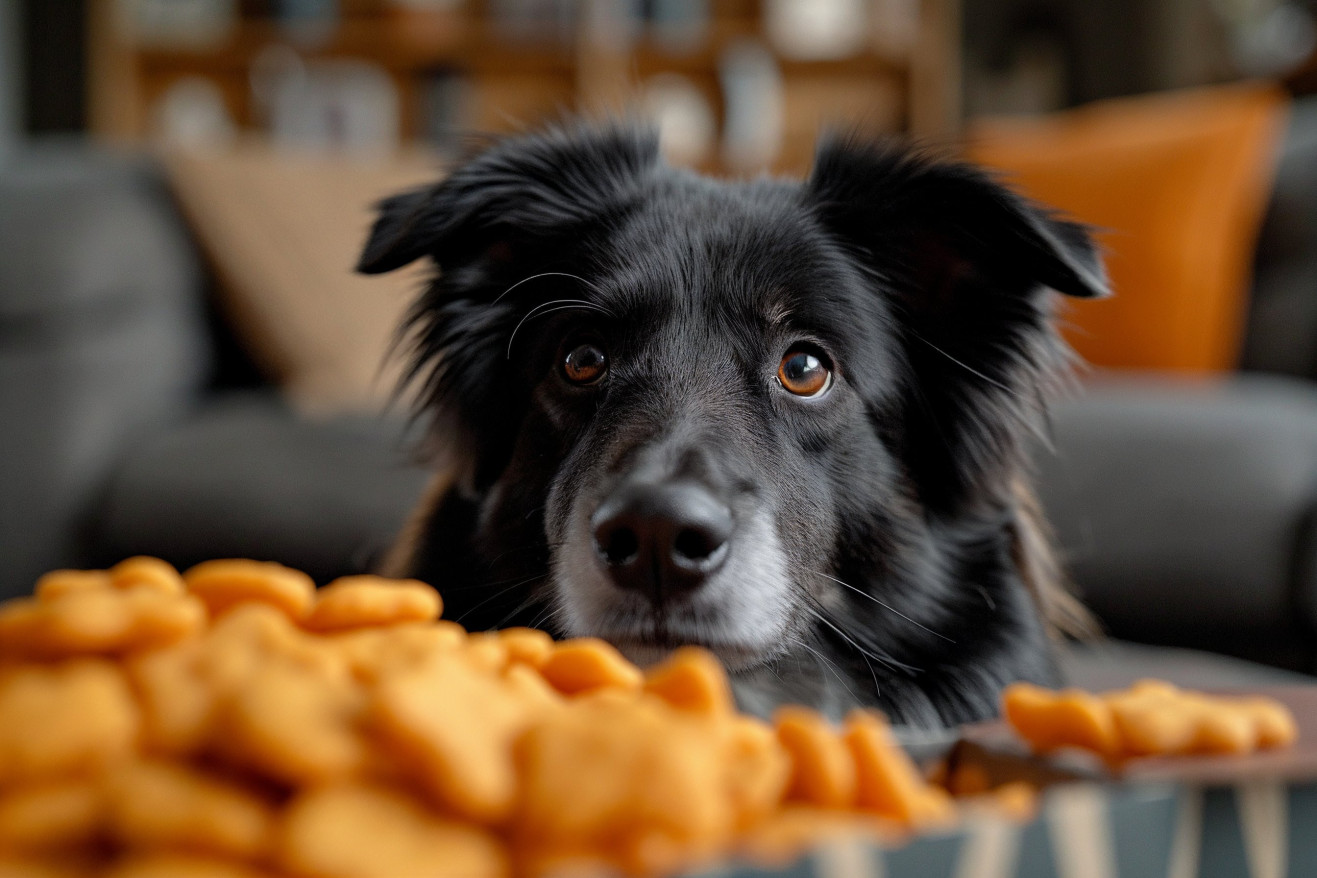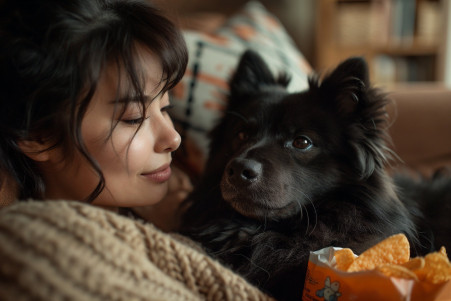Can Dogs Eat Goldfish Crackers? Unpacking the Snack Dilemma
2 February 2024

Those little, cheesy crackers are hard to resist, but can dogs have Goldfish crackers? No, we do not recommend Goldfish crackers for dogs. Not only do they contain onion powder and garlic, which are toxic to dogs, but they also have high levels of sodium. While eating them once in a while may not cause any issues, it’s best to stay away from these snacks and stick to treats made specifically for dogs.
This article will delve into veterinary expert opinions and nutritional breakdowns that will help explain a dog’s diet and the potential dangers of feeding them human snacks. Our investigations cover topics in canine health, toxicology, and nutrition to give a well-rounded look at the impact of sharing our snacks with our pets. This will help you better understand how to satisfy your dog’s cravings in a way that’s safe and healthy for them.
Can dogs eat Goldfish crackers without experiencing negative health effects?
The Dangers of Goldfish Crackers for Dogs
Goldfish crackers may be a popular snack for people, but there are a few ingredients in them that can be dangerous for dogs. Onion and garlic powder, which are often used to flavor Goldfish crackers, are part of the allium family, which is toxic to dogs.
A report from DVM360 explains that consumption can result in oxidative damage to red blood cells, causing them to rupture and leading to anemia, which can cause symptoms like weakness, pale gums, and an increased heart rate.
Salt is another ingredient that can be harmful to dogs. A study posted in PubMed explains that salt poisoning in dogs can lead to hypernatremia, which can cause dehydration, seizures, and death. It is important to watch for signs of food poisoning in your dog, including increased thirst, vomiting, and lethargy, which can indicate that your dog is having a reaction to these toxic ingredients.
If your dog has eaten a large amount of Goldfish crackers, it is important to contact your vet right away. Love Your Dog explains that you should call your vet for advice if you notice your dog is in distress. Being aware of these dangers and acting quickly can help ensure that your dog stays safe from the potential risks of eating human food.
Analyzing the Nutritional Value of Goldfish Crackers for Dogs
Goldfish crackers are not a good choice for dogs. The first ingredient in Goldfish crackers is enriched flour, which doesn’t have much nutritional value for dogs.
According to Rover.com, dogs don’t need flour in their diets, and they certainly don’t need the enriched kind that’s often found in human snacks. Enriched flour is often processed to the point that it’s been stripped of its nutrients, and it can even lead to allergies in dogs.
The vegetable oils used in Goldfish crackers are also problematic. As Monica Isabella Cutrignelli notes in PMC, dogs need fatty acids that they can’t synthesize on their own, including linoleic and α-linolenic acids, but the ratio of fats in their diet is important. The wrong ratio of fats can lead to issues with a dog’s gut microbiome and overall health.
In addition, the preservatives used in Goldfish crackers to ensure they have a long shelf life could be harmful to dogs. Dogs need a diet that’s high in protein and certain carbohydrates to provide them with energy, according to a study in PubMed on the use of high-starch flours in dog diets. Unfortunately, the nutritional content of Goldfish crackers doesn’t meet these requirements, as it lacks essential nutrients and contains potentially harmful additives.
Better options for dog treats include treats that are specifically formulated for dogs or homemade treats that use ingredients that are safe for dogs, such as certain whole grains, lean meats, and vegetables, and that provide the right balance of nutrients. Knowing the differences between human and dog nutrition is important for dog owners who want to make sure their pets stay healthy.
Canine Behavior: The Impact of Human Snacks
When it comes to feeding dogs human snacks like goldfish crackers, the impact on their behavior may be more complex than you think. Dogs develop taste preferences and eating habits that can be shaped by the food they consume.
A study published in PMC explains that while dogs have fewer taste receptors than humans, they still have a preference for certain tastes and can learn to like certain foods. This can lead to picky eating, especially if they’re being fed snacks like goldfish crackers.
Using treats to reinforce behavior is a well-documented way to shape a dog’s actions. Research published in ScienceDirect shows that feeding dogs human snacks as an occasional treat can be used to reinforce behaviors, but this can also lead to potential issues. If a dog learns that they get human snacks when they beg or misbehave, they can start to associate these behaviors with the reward, which can undo training and cause behavioral problems.
As the American Kennel Club points out, feeding dogs human snacks over the long term can also lead to obesity and nutritional deficiencies. Healthy treat-giving means choosing snacks that are safe and nutritionally appropriate for dogs and based on their natural diet to help reinforce healthy behaviors. Understanding the impact of our choices on behavior is essential to making sure our dogs are happy and well-behaved.
Give Your Dog These Healthy Alternatives Instead
When it comes to the dog treat aisle, you may have an easier time than you think. Instead of goldfish crackers, there are a few things that you can give your dog that you probably already have in your kitchen.
Raleigh Vet suggests fruits and vegetables like apple slices (minus the seeds and core), green peas, carrots, and blueberries because they are full of vitamins and fiber, which makes them great low-calorie dog treats. In addition, watermelon slices (minus the seeds and rind) and cooked sweet potatoes are hydrating and full of nutrients.
These whole-food treats are full of vitamins, minerals, and antioxidants that are good for your dog. A study published in PMC notes that the digestibility of treats is important, and these natural options are generally easy for dogs to digest.
Make sure to give your dog a small amount of any new treat to see how they react to it.
If you want to make your dog a treat, consider mashing up some sweet potatoes or blending up some fruit to make a smoothie.
Petco notes that treats should only make up a small portion of your dog’s diet, and you should make sure that they are a healthy addition to the food that they eat every day. If you make sure that you are picking treats that are good for your dog’s dietary needs, you will be well on your way to keeping your dog healthy and happy.
Final Thoughts on Feeding Your Pup Goldfish Crackers
In summary, goldfish crackers are not a good choice for dogs to eat, mostly because of their high sodium content and the presence of ingredients that are toxic to dogs, including onion and garlic powder. As noted by Pet Keen, these ingredients can cause gastrointestinal upset and even more serious health problems like anemia and hypernatremia, which can be deadly in extreme cases.
Knowing what your dog needs nutritionally is important for their overall health and well-being. PetMD and the Association of American Feed Control Officials have detailed what a well-balanced diet looks like and why it’s important for your dog to have one.
When it comes to treats, it’s important to make sure that you’re giving your dog safe, nutritious options that meet these dietary requirements. For example, cooked carrots, pumpkin, and lean meats can provide your dog with important nutrients without the risks that come with human food.
By making healthy choices about what we feed our dogs, we can help them avoid potential health problems and ensure that they live long, healthy lives. By making sure that the treats we give them are safe, we can help them stay healthy and strengthen the bond we have with our pets.


